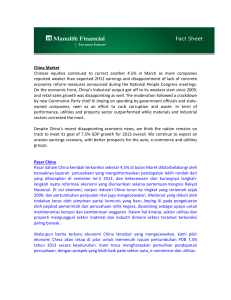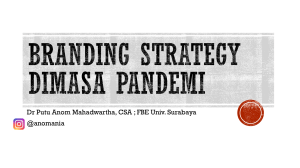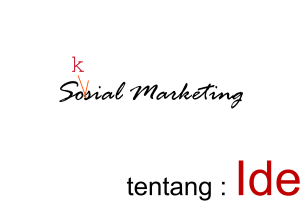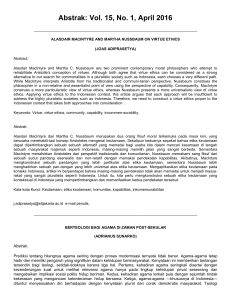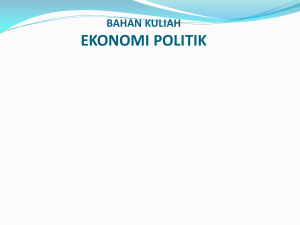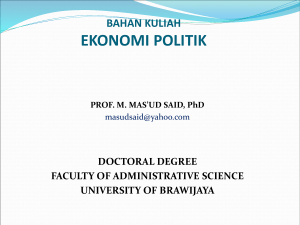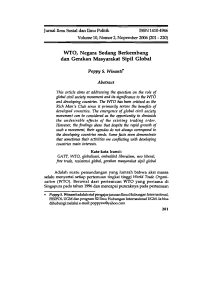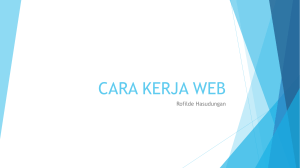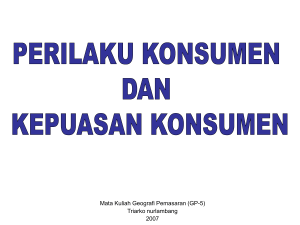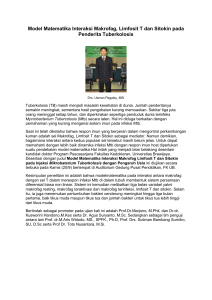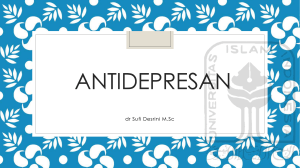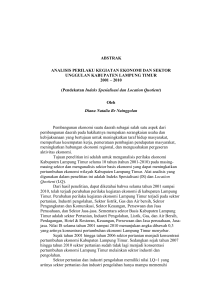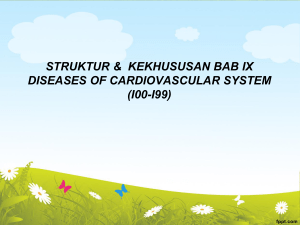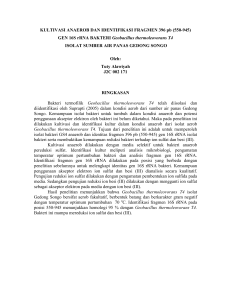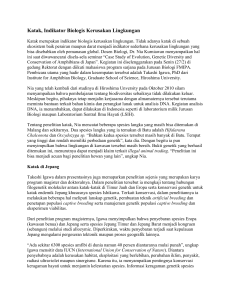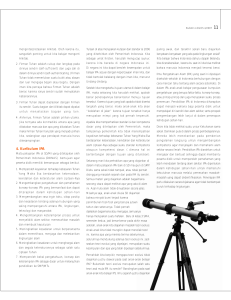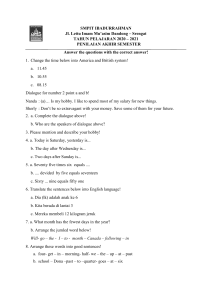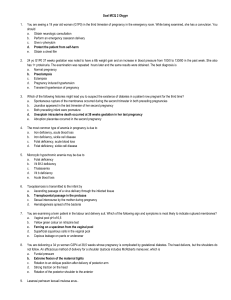Makro Ekonomi - WordPress.com
advertisement
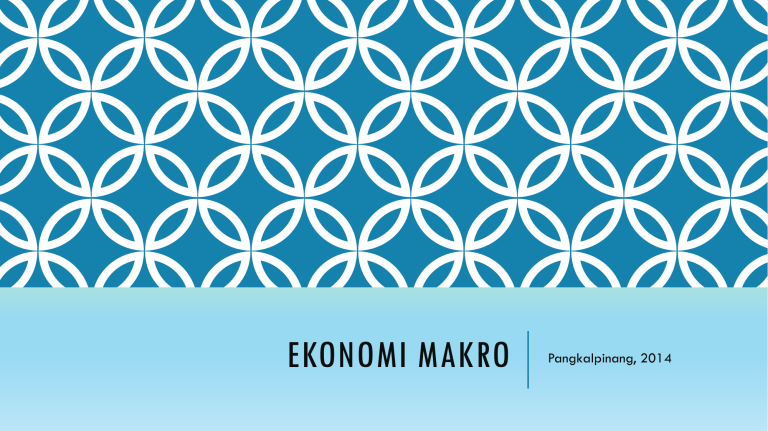
EKONOMI MAKRO Pangkalpinang, 2014 TENTANG APAKAH EKONOMI MAKRO? ekonomi makro mempelajari ekonomi agregat dan dampak kebijakan Apa yang menentukan fluktuasi ekonomi? (siklus bisnis, business cycle) Kenapa Pertumbuhan beberapa negara lebih cepat? (pertumbuhan ekonomi) Apa penyebab pengangguran? Apa yang mendorong perubahan harga? (inflasi) Apa peran pemerintah dan kebijakan ekonomi? (kebijakan moneter dan fiskal) Bagaimana sistem ekonomi global memengaruhi perekonomian satu negara? File: acpms_04des2013 EKONOMI MAKRO DALAM BERITA RESMI PDB PDRB Ketenagakerjaan Inflasi Expor-Impor Perkembangan Industri LITERATUR: Mankiw, N.G., 2010. Macroeconomics, seventh ed., Worth Publishers. Snowdon, B. & Vane, H. R, 2005.. Modern Macroeconomics, Edward Elgar Publishing, Inc. Dornbusch, R. & Fischer, S., 1997. Macroeconomics, sixth ed., McGraw_Hill’s. MIT1 TOPIK 1: PENGENALAN DATA MAKRO 1. Produk Domestik Bruto (PDB) – Apa dan bagaimana mengukur PDB? Kenapa Penting? – Definisi komponen Pengeluaran (expenditure). – What are the trends in these components over time? 2. Inflasi – Apa perbedaan antara peubah ‘Real’ dan ‘Nominal’? – bagaimana mengukur Inflasi? 3. Suku Bunga (Interest Rate) – Mengapa kita peduli terhadap inflasi? 4. Penganggur (Unemployment) – Bagaimana mengukur Penganggur? – Kenapa Kita Peduli terhadap Penganggur? 1. PDB PDB adalah suatu ukuran output! • Kenapa kita peduli? Karena output berkorelasi (pada saat tertentu) dengan hal-hal yang kita peduli (standar hidup, upah, penganggur, inflasi, defisit anggaran dan perdagangan, dsb...) Definisi formal: PDB adalah seluruh nilai tambah barang dan jasa yang dihasilkan di wilayah geografis suatu negara selama periode waktu tertentu (triwulanan, tahunan). PDRB Provinsi atau Kabupaten TIGA CARA MENGHITUNG PDB Sisi Produksi: Menghitung jumlah nilai tambah (value added) semua pelaku usaha (value added = sale price less cost of raw materials) Nilai tambah bruto = Output – biaya antara Sisi Pendapatan: Labor Income (wages/salary) + Capital Income (rent, interest, dividends, profits)+ Government Income (taxes) Sisi Pengeluaran: Spending by consumers (C) + Spending by businesses (I) + Spending by government (G) + Net Spending by foreign sector (NX) total production = total income = total expenditure CONTOH SEDERHANA BAGAIMANA MENGHITUNG PDB Transaksi Jeruk Upah pekerja Pajak ke Pemerintah Rp. (juta) 15.000 5,000 Hasil Penjualan (Revenue) Jeruk 35.000 a. Ke Konsumen (rumah tangga) 10.000 b. Ke Industri Jus Jeruk 25.000 Pajak ke Pemerintah Belanja Jeruk Revenue Sisi Produksi: (value added: sales – intermediate good): = 35M + (40M– 25M) = 50M Sisi Pendapatan: (Wages + Profits + Taxes) = (15M + 10 M) + (15M + 3M) + (5M + 2M) Transaksi Industri Jus Jeruk Upah pekerja Berapakah jumlah Nilai Tambah (Rp) yang dihasilkan dari kedua aktivitas tersebut? 10.000 2.000 25.000 40.000 Sisi Pengeluaran: (expenditure by final users): = 10M + 40M = 50M PRODUKSI ‘SETARA’ PENGELUARAN PDB adalah sebuah ukuran Produksi Pasar (Market Production)! Nilai Pasar (Market value) =Berapa yang harus anda bayar untuk membeli • apa yang diproduksi di pasar seharusnya menunjukkan yang dibelanjakan oleh pelaku ekonomi; • siapakah pelaku ekonomi yang kita perhatikan pada sisi pengeluaran? – Consumers (refer to expenditure of consumers as “consumption”) – Businesses (refer to expenditure of firms as “investment”) – Governments (refer to expenditures of governments as “government spending”) – Foreign Sector (refer to expenditures of foreign sector as “net exports”) • For us, we will predominantly spend our time working with the Expenditure Approach: ******* Y = C + I + G + NX ****** KEMBALI KE CONTOH SEDERHANA Saya menghasilkan Jeruk dan secara potensial saya dapat: – menjualnya ke konsumen domestik (Consumption) – menjualnya ke business (Investment) – menyimpannya dalam lumbung stok saya sebagai inventory (Investment) – menjualnya ke pemerintah (bulog) (Government spending) – menjualnya ke luar negeri (Net Export) DEFINISI KOMPONEN PENGELUARAN Consumption (C): – The Sum of Durables, Non-Durables and Services Purchased Domestically by Non-Businesses and Non-Governments (ie, individual consumers). – Includes Haircuts (services), Refrigerators (durables), and Apples (non-durables). – Does Not Include Purchases of New Housing. Investment (I): – The Sum of Durables, Non-Durables and Services Purchased Domestically by Businesses – Includes Business and Residential Structures, Equipment and Inventory Investment – Land purchases are NOT counted as part of GDP (land is not produced!!) – Stock purchases are NOT counted as part of GDP (stock transactions do NOT represent production – they are saving!) There is a difference between financial and economic investment!!! DEFINISI KOMPONEN PENGELUARAN (LANJUTAN) Government Spending (G): Goods and Services Purchased by the domestic government. • For the U.S., 2/3 of this is at the state level (police and fire protection, school teachers, snow plowing) and 1/3 is at the federal level (President, Post Office, Missiles). • NOTE: Welfare and Social Security are NOT Government Spending. These are Transfer Payments. Nothing is Produced in this Case. • Net Exports (NX): Exports (X) - Imports (IM); – Exports: The Amount of Domestically Produced Goods Sold on Foreign Soil – Imports: The Amount of Goods Produced on Foreign Soil Purchased Domestically. KEYNES (Y = C + I + G + NX) Makroekonomi mempelajari Y (= aggregate supply) dan C+I+G+NX (aggregate demand), dan menunjukkan bagaimana harga/upah/suku bunga/nilai tukar harus disesuaikan sehingga AS = AD. – ekonomi klasik percaya harga/upah bergerak mendekati keseimbangan. – Keynesian economics sticky prices/wages give rise to unemployment and an active role to monetary policy. • dengan susunan dasar ini kita dapat memahami bagaimana perubahan dalam AD dan AS memengaruhi pertubuhan dan harga dalam sebuah ekonomi. 2. INFLASI Perubahan harga: Naik inflasi Turun deflasi Tugas: (1 minggu) 1. Cari komponen Inflasi Inti, Bergejolak, dan Yang Diatur oleh Pemerintah. 2. Defenisikan Cost push Inflation dan Demand Pull Inflation 3. SUKU BUNGA (INTEREST RATE) Central Banks are very interested in r since it may affect the savings decisions of households and definitely affects the investment decisions of firms. The press talks about Central Banks setting i, but the Central Banks are really trying to set r. i(0,1) = the nominal interest rate between periods 0 and 1 (the nominal return on the asset) Πe (0,1) = the expected inflation rate between periods 0 and 1 re (0,1) = the expected real interest rate between periods 0 and 1 Definisi: Perkiraan (approximate) re = i – Πe CONTOH An Example of how inflation can affect real returns. • Suppose we agree that a real rate of 0.05 over the next year is fair. – borrowing rate, salary growth rate, etc. • Suppose we also agree that expected inflation over the next year is 0.07. • We should then set the nominal return equal to 0.12 (i = re + лe) Summary: i = 0.12, re = 0.05, лe=0,07 • Suppose that actual inflation is 0.10 (лa > лe) In this case, ra = 0.02 (ra = i - лa) Borrowers/Firms are better off Lenders/Workers worse off • Suppose that actual inflation is 0.03 (лa < лe) In this case, ra = 0.09 (ra = i - лa) Borrowers/Firms are worse off Lenders/Workers better off It has been shown that higher inflation rates are correlated with more variability. People/Firms Don’t Like the Uncertainty 4. PENGANGGUR Angkatan Kerja = Pekerja + Penganggur pencari kerja Tingkat Pengangguran = Penganggur pencari kerja/angkatan kerja Baca Pikirkan! Kenapa kita peduli terhadap penganggur?

